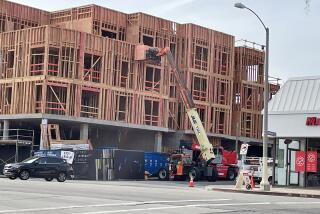North County Voters to Decide Growth, Property-Rights Issues : San Marcos Asks More From Developers
- Share via
A so-called growth-management ordinance that would not limit growth but at least require developers to pay their fair share of public improvements--including new schools to help relieve overcrowding--will go to San Marcos voters June 7.
The proposal is intended to help the city keep pace with growth by forcing developers to pay not only for their on-site improvements, as has always been the case, but also to help pay for improved roads, new parks, new school sites and other public works.
The measure, proposed by a citizens’ task force, was adopted by unanimous vote of the San Marcos City Council on Tuesday night.
Lauded by Schools Superintendent
The plan was immediately hailed by schools Supt. Mac Bernd as invaluable in helping meet the demands of a burgeoning San Marcos Unified School District student population.
The amount a developer would have to pay or the improvements he would have to make to win city approval of a project would depend on the scope of the project and the particular needs of the neighborhood, city officials said.
City Manager Rick Gittings said larger developers recognize the ordinance’s requirements as “the cost of doing business in San Marcos,” but he acknowledged that smaller developers might balk at the proposed public facilities law.
Developers will have to understand, Gittings said, “that the old philosophy is disappearing that held, ‘This is my property, and I want to do anything I want with it and you can’t tell me not to.”’
“A lot of communities are heading in this direction. They see it as a more realistic alternative than establishing building caps or things like that. The concern most expressed by the public is not so much that growth per se is bad but that growth is bad if there aren’t adequate facilities to maintain the quality of life in the area. If the streets aren’t backed up in traffic or the parks aren’t overcrowded, then it’s not quite so traumatic for the community to see some growth occur.”
The impact of the proposed ordinance might be felt most directly in two areas: lessened traffic congestion and school overcrowding.
The ordinance, for instance, would require developers to negotiate with the school district on how to mitigate the development’s impact on local schools, perhaps by having to provide a school site or, in the extreme, build a new school altogether.
The final decision, however, would have to come from the city, not the school district, because state law prohibits school districts from requiring developers to pay for any new schools as a condition to build.
Instead, schools are allowed to assess impact fees of up to $1.53 per square foot of residential construction to help pay for new schools.
Those fees, however, fall far short in meeting the district’s school construction needs. Jeff Okun, school facilities administrator for the district, said Wednesday that the district collected $1 million last year in developer fees, but $5 million in school construction is needed to house the students generated by those developments.
Currently, 1,253 students of the district’s 6,905 students are housed in relocatable classrooms because of overcrowding because schools haven’t been able to keep pace with the city’s growth.
State law, however, does not ban cities from requiring developers to assist with the construction of new schools as a condition for approval of their projects.
Supt. Bernd said the ordinance forcing developers to work with the school district is indicative of the city’s cooperation with the school district on other issues, including the city’s agreement to pay $800,000 toward building a new school that will open in the fall.
“To get this kind of cooperation between a city and a school district, elected officials have to look beyond their own political fortunes and look for the good of the community,” Bernd said. “Here in San Marcos, we have that kind of cooperation.”
In contrast, for instance, neighboring Escondido has no such cooperation between City Hall and the elementary and high school districts serving that city. School officials there have long been frustrated because the city has approved new residential projects without requiring developers to provide new school facilities.
Today, Escondido’s schools are overcrowded, and two elementary schools will begin year-round schedules in the fall to handle the overflow.
Bernd said that when a developer comes to the San Marcos school district to discuss its impact on local schools, “We won’t take them to the cleaners. But we will want them to meet their entire impact on the school district. That’s their responsibility. I don’t know if we hold all the cards (in potentially blocking new development unless the developer meets the schools’ needs), but it gives us a strong hand. I’d rather be sitting at the table with a full house than a pair of deuces.”
City Manager Gittings is confident that the school district would not abuse its position. “They’ve shown good sense in the past, and it’s my perception that the district will work hard at being reasonable and fair while, at the same time, addressing the issues of concern to the community.”
San Marcos Planning Director Jerry Backoff said the first step in planning the implementation of the proposed ordinance is to determine what public facilities in the city are lacking--including streets and new parks--and to figure out those costs.
Developers would then be assessed a “fair share” of those costs based on the size of their project. It was premature, he said, to determine how the ordinance might increase the cost of buying a home or renting in San Marcos, or whether developers may steer away from San Marcos because of the added cost of doing business.
The ordinance also would require developers to pay for such public works as reservoirs and water lines, though that requirement already is made by the independent San Marcos County Water District before it blesses new development.
“But the ordinance would reinforce what we already are doing, and that is good,” said Bill Rucker, general manager of the water district. “After all, the city holds the bottom-line control on subdivision maps, and they’re the ones to make sure a developer meets everyone’s needs.”
Backoff said developers also would be required to pay for their share of increased Sheriff’s Department protection, fire protection, and conceivably even for additional library services to supplement the county’s San Marcos branch.
Road funding would resolve a problem common now in San Marcos, where major thoroughfares, such as San Marcos and Rancho Santa Fe boulevards, vary from two to six lanes.
Whether through up-front cash, assessment districts self-imposed by the developer, or other financing mechanisms, the city would receive new revenue to improve those and smaller streets, thereby relieving the city of some of the burden in paying for that work through its capital improvements budget.
The ordinance would require developers to pay the money, or make the necessary public improvements, before or at the time of construction so the improvements would be completed when the development is occupied.
More to Read
Sign up for Essential California
The most important California stories and recommendations in your inbox every morning.
You may occasionally receive promotional content from the Los Angeles Times.










